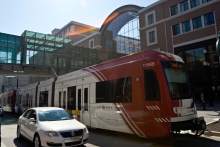This is an archived article that was published on sltrib.com in 2015, and information in the article may be outdated. It is provided only for personal research purposes and may not be reprinted.
Steeply discounted transit passes for Salt Lake City residents survived a disappointing first year to see a second act — but will cost more and no longer include FrontRunner commuter rail service.
City residents will be able to buy passes one month at a time, no longer facing a requirement to buy an annual pass to receive deep discounts.
"Folks let us know that having a month-to-month option versus an annual contract would be a benefit. It's something that allows people to utilize the pass when they most need it without needing to make the yearlong commitment," said Art Raymond, spokesman for Salt Lake City Mayor Ralph Becker.
The Hive Pass was launched with much fanfare a year ago. The city hoped to sell 6,000 passes to help reduce pollution and congestion, but sold only 3,000 — even though they cost just $360 a year, a discount of $2,016 from the full retail price for all-transit access.
Raymond said the city found that many people had a tough time coming up with that initial $360 price tag in a lump sum, or committing to it through monthly payments on utility bills.
The new Hive Pass will now cost $42 a month. While that's $12 more monthly than the old pass, it is half the price of the $83.75 retail cost of a monthly Utah Transit Authority pass that offers equivalent service.
The new Hive Pass may be purchased one month at a time, whenever needed. If residents choose to purchase all 12 months in advance, the price will be $475 — a $29 discount from the purchase of 12 monthly passes.
But the pass will include only bus, TRAX and Sugar House streetcar service. It no longer will include the FrontRunner commuter rail.
"We found that relatively few of our pass holders last year used FrontRunner, less than 10 percent of them," Raymond said. Eliminating that service helped hold down costs and subsidies being provided by the city and the UTA.
Raymond said the city is providing about $1 million to subsidize the pass program, including costs of administration and marketing. It is limiting the number of available passes to 2,500 to fit in that budget.
If all 2,500 sell, the city could look at expanding the program and subsidies.
The city is giving current Hive Pass holders the first opportunity to buy new passes. Remaining ones will go on sale to other city residents after May 1, Raymond said.
New Hive Passes — which will begin working on May 1 — may be purchased at the city treasurer's office in City Hall, 451 S. State, or at the Salt Lake City Public Utilities Office, 1530 S. West Temple. More information is available online at ridewithhive.com.
Sales of the passes had been halted last October as the city and UTA reviewed results of the program to decide whether to continue it.
Even though far fewer passes were sold last year than hoped for, Raymond said those who did buy them gave the program high ratings.
"The pass saw a customer satisfaction rate of over 90 percent," he said.
Most of the people who initially bought passes were already using transit — but new transit riders were attracted more in later months, Raymond said.
"A quarter to a third of those [pass buyers] were people who significantly changed their transit habits, going from riding once a month to several times a week," Raymond said.
"It really opened transit access to a whole new group of people. ... They could get on transit more often because they have a cheap pass in their pocket."
UTA spokesman Remi Barron praised Salt Lake City as "a great champion of transit and a good partner in launching this innovative residential transit pass program, the first of its kind."
He added, "We learned a lot from the initial pilot as far as creating a sustainable program that meets our shared objectives for both ridership and revenue."
UTA has had no substantive dialogue with other cities about offering similar passes, but Barron said the agency is open to that.



